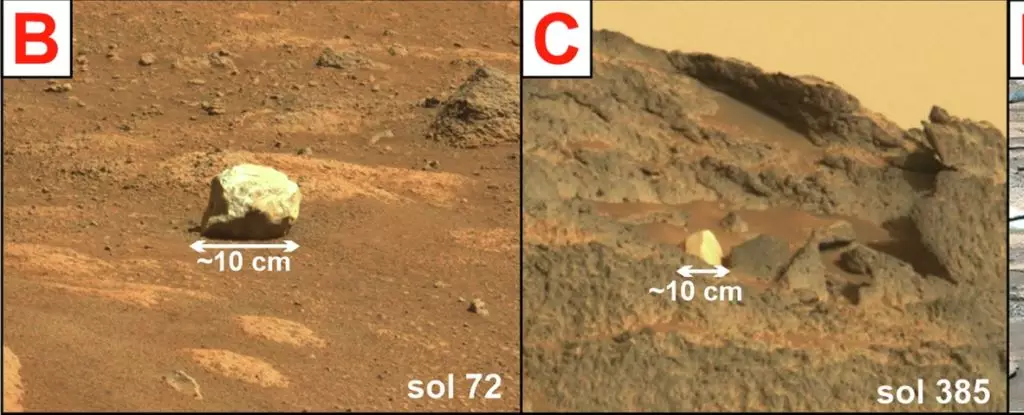Recent findings from the Jezero Crater on Mars are shaking the foundations of our understanding of the red planet’s history. Researchers have uncovered pale rocks that whisper of an epoch when conditions may have been strikingly warm and wet. These insights, gathered through active exploration by NASA’s Perseverance rover, suggest that Mars might have once harbored environments similar to those that foster life on Earth. As planetary scientist Roger Wiens of Purdue University aptly puts it, “These minerals are what’s left behind when rock has been in flowing water for eons,” unlocking questions about Mars’ capability to support life.
What stands out in this research is the significance of the mineral kaolinite, a silicate clay that forms only under specific conditions reminiscent of Earth’s bio-diverse environments. The presence of this mineral brings forth a cascade of questions: What exactly did Mars look like during its formative years? Was it hospitable? The chilling extremities we associate with Mars today seem a stark contrast to its possibly nurturing past.
The Role of Perseverance and Advanced Technology
As we probe deeper into Martian geology, the crucial role of advanced technology cannot be understated. Perseverance is more than just a rover; it serves as our ambassador in a realm that remains largely alien. Using a sophisticated tool known as Laser Induced Breakdown Spectroscopy (LIBS), Perseverance analyses the materials found on Mars’ surface by firing laser pulses that vaporize tiny mineral samples. This high-tech method allows scientists back on Earth to decode the resulting light emissions, yielding elemental compositions that unveil intricate stories from the Martian soil.
The discovery of float rocks, which are displaced remnants transported from their original home by ongoing geological processes, increases the complexity of Mars’ geological narrative. These peculiar formations were first spotted within Jezero Crater, and their unique appearance demanded a closer examination. As Wiens points out, the findings are not just unexpected; they are enigmatic, challenging our pre-existing notions of Martian history.
The Striking Differences in Kaolinite
One notable revelation is that the kaolinite found on Mars exhibits a hardness that diverges from its terrestrial counterpart. This anomaly raises questions about the weathering processes Mars underwent, hinting that its past conditions may not have merely mirrored our own. Such variations indicate that understanding the extent and nature of water on Mars could lead us to significant implications regarding its habitability.
Not to be overlooked, the identification of spinel—an aluminum-rich mineral often found in gemstones on Earth—within the kaolinite offers another layer to the puzzle. Earthly spinel typically forms under specific conditions, thus suggesting that the Martian spinel might also reveal critical insights regarding its geological history and formation processes. The combination of these minerals implies diverse interactions between water and rock over expansive periods, hinting at a potentially rich history of aquatic processes that shaped the planet’s surface.
Unraveling Mars’ Water History
Addressing the tantalizing questions surrounding the volume and duration of water on Mars is critical to understanding its past. Wiens emphasizes, “The big questions about Mars are about water. How much water was there? How long was there water?” This inquiry is spurred not only by scientific curiosity but also by its implications for the potential for life as we know it. The reality that kaolinite can contain bound water within its mineral structure suggests a dynamic past where water was not merely a rarity, but perhaps a significant player in shaping the planet’s surface.
As we continue to decode these rocky narrators of Mars’ history, every mineral presents new possibilities for understanding the planet that has captivated our imagination for decades. The evolving narrative surrounding Jezero Crater is not just about geological formations; it’s a saga that challenges us to reconsider what we know about the existence of life beyond Earth.
The Broader Implications of Mars Research
Research on Mars not only contributes to planetary science but also compels us to reflect on our own Earth’s history and climate resilience. As we draw comparisons between terrestrial and extraterrestrial environments, the lessons learned transcend scientific interest, fueling our commitment to understanding climate change and the delicate balance of ecosystems on Earth. Exploring other worlds thus becomes an act of introspection, magnifying our understanding of life’s potential across the cosmos while grounding us in the urgent need to safeguard our own planet’s future.

